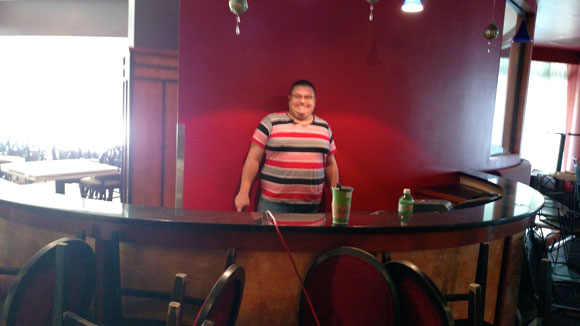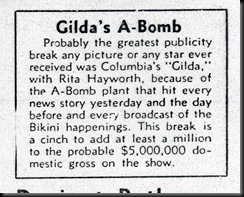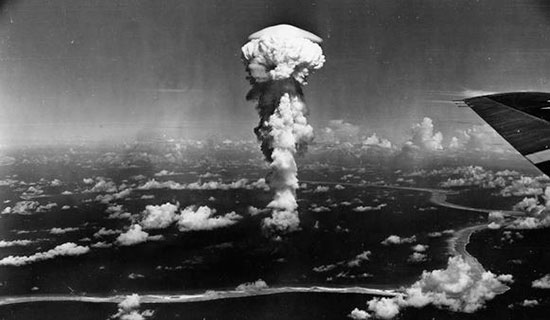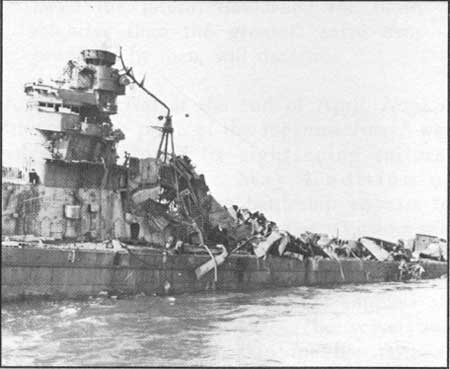
(Hollywood Bombshell Rita Hayworth in her 1946 role of “Gilda.” The Fat Man A-Bomb used for the ABLE test at Bikini was named for her and her likeness was stenciled on the weapon prior to M-hour).
We had abandoned ship the afternoon before the bomb dropped for Test ABLE. We were taken by landing craft to the observation anchorage some ten miles east of the center of the target ship anchorage centered around the battleship Nevada in her merry red paint. We rose early on ABLE Day to await M-hour. We were supposed to be ready for the greatest demonstration of raw destructive power in the world’s history.
The type bomb, I learned later, was one of the “Fat Man” implosion bomb designs that had been used at Nagasaki. The press was having a field day with the Public Affairs staff of Joint Task Force ONE under Rear Admiral Blandy. The bomb itself had been named after an actress who was termed a bombshell herself. Rita Hayworth played a character named “Gilda” in the Hollywood movie of the same name that summer.

Prior to dawn, preparations were in progress on the support ships all over the task force and at air bases on the atolls in the region. Eight B-17 Flying Fortress bombers had been modified with radio-controlled autopilots, converting them to remote control drones loaded with automatic cameras, radiation detectors, and air sample collectors. Being un-manned, the Forts could fly into radiation environments, such as the mushroom-shaped cloud that the ABLE blast would produce. It was assumed that such exposure would be fatal to human aircrew.
All the land-based detonation-sequence photographs were taken by remote control from tall lattice-based towers erected on several islands of the atoll. In all, the Public Affairs people had announced that the Bikini cameras would take 50,000 still pictures and a million and a half feet of high-speed motion picture film.
Gilda was going to be dropped from Superfortress B-29-40-MO 44-27354 from the 509th Bombardment Wing. That was the elite successor Wing to the Roswell, New Mexico-based unit that had conducted the atomic bombings of Japan. “Dave’s Dream” had in fact been at Nagasaki, then named “Big Stink.” Under that nose-art the aircraft had an admirable operational record, being flown by the greatest number of crews assigned to the mission. She was re-named for the Crossroads mission in honor of Captain David Semple, a 509th bombardier who had been killed in a crash that year.
For ABLE, the pilot would be Major Woodrow Swancutt, assisted by Copilot Captain William C. Harrison, and Bombardier Major Harold H. Wood. All the moving parts were headed in the right direction, and on the observation ships emotion and interest were rising. In the final minutes before the drop, we heard the call to make preparations to protect our eyes, either by turning away, holding our arms over our faces or wearing special goggles. There was not a man among us who did not want to see the dawn of a new age for ourselves.
And that is precisely when the SNAFU began. Situation Normal, All F**ked Up.

(The “Able” test of Operation Crossroads, the first atomic bomb dropped on the Bikini lagoon, on July 1, 1946. Credit: Government photo in the public domain).
GILDA detonated 520 feet above the target fleet, with a yield of 23 kilotons. Five ships were sunk, including two attack transports that went down immediately, two destroyers that followed within hours, and our former steaming partner, the ex-IJN cruiser Sakawa the next day.

(Ex-IJN cruiser Sakawa immediately after the blast. Photo USN).
To many of us, the event was a bit of a disappointment. One of the pirate crew swore that the blast sounded like a wet firecracker. Despite the towering plume, some of the 114 press observers expressed disappointment at the effect on the target ships. The New York Times reported (prematurely, as it turned out) that “only two were sunk, one capsized, and eighteen damaged.” Cover-your-ass began immediately with SECNAV James Forrestal formulating the position that “heavily built and heavily armored ships are difficult to sink unless they sustain underwater damage.”
Dark rumors circulated that Navy had rigged the test to disadvantage proponents of a new, independent Air Force that would be established as a peer to the existing Departments of War and the Navy.
Actually, the reason for the SNAFU had no conspiracy, but equally no simple answers. GILDA had missed the aim-point of the battleship Nevada, by 710 yards. Meteorologists reported that high humidity in the lagoon absorbed much of the radiant light and heat energy. Others speculated that the spectacle was minimized due to the fact that observers were prudently located much further away than they had been on the first atomic test at Trinity flats in New Mexico.
The actual detonation point, west-northwest of Nevada, was closer to the attack transport USS Gilliam in an area with a much less dense aggregation of target ships.
The military did what it does best, and launched an immediate investigation of the aircrew of Dave’s Dream. A variety of factors for the miss were offered up, including Gilda’s known poor ballistic characteristics, but none was definitive. Images of the drop were inconclusive. The bombsight was checked and found to be calibrated properly and error free. Drops of the bomb simulators- the “pumpkins” were also held and checked out to be within tolerance. Commander of the 509th Col. Paul Tibbets, the man who had flown Enola Gay to Hiroshima, opined the miss was caused by pilot and bombardier error.
The smart money maintained that had the bomb exploded over the Nevada as planned, at least nine ships, including two battleships and an aircraft carrier, would likely have sunk.
After a couple hours, scientists, technicians and Navy divers swarmed over the ships with Geiger counters, to assess damage, and some began to sweep down the ships to ameliorate the radiation. Other crews returned to the target ships to put out fires. Nagato floated placidly just where we left her, apparently inured to the power of the atom.
We waited a day, and then returned to our battleship in the target zone. We discovered that the ship was s, but otherwise intact. The long boat had been blown to bits, and the decks were scorched, but otherwise there was no damage. My stateroom had a quarter of inch of rust particles on the floor. Evidently the ship had shaken itself like a wet dog, and rust had spurted from every joint. Everything was mildly radioactive, but not enough to worry about. We lived on board just as before, preparing for the BAKER test, and I went back to the coral head to swim during the day.
The Moray Eel appeared to have survived the ABLE test just fine.

(Sakawa goes down by the stern the day after the ABLE test. In the center is Nevada, the ostensible target of the blast, while Nagato is in the upper right. Combat Art from LCDR Art Beaufort. Photo USN).
Copyright 2015 Vic Socotra
www.vicsocotra.com
Twitter: @jayare303
